Custom Finish Capabilities
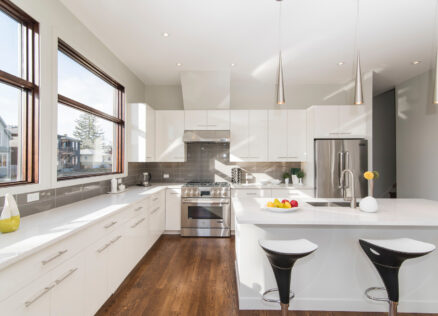
We work hard to take the stress out of finding the perfect finish. We offer a full range of finishes and wood species so you can get the look you've always wanted for your home, office or cottage. Contemporary, Rustic, Victorian, Colonial, Shaker, Euro-style, Mission. We've got it covered. - and we're constantly keeping up on the latest design trends.
Here is a great online catalog with examples of some popular finishes in the industry today:

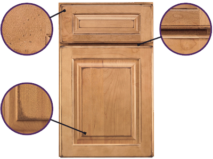
Burnished Finishes
Availability varies on Maple, Cherry, Birch and Hickory - This technique creates the warm, traditional look of fine furniture. Unfinished doors and drawer fronts are randomly distressed and then over-sanded. Next, a darkening stain is artistically applied to the corners and raised areas, creating a burnished effect. A base stain is then applied and carefully hand-wiped. Burnished finishes are created by a very complex process: random distressing, over-sanding and application of a burnishing stain. The random distressing and hand-applied techniques of burnishing produce one-of-a-kind results where no two doors are exactly alike. Burnished Ginger and Burnished Chocolate include flyspeck highlights. This technique involves a random spattering of a complementary finish color, which adds depth and dimension to the finish.

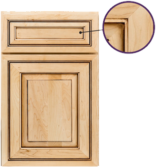
Highlighted Finishes
Available on Maple, Oak, Cherry, Birch and Hickory - A base stain color is hand-rubbed into the wood for maximum absorption. Next, a highlight glaze is hand-applied to the recesses in the door and drawer fronts, adding depth in color without altering the appearance of the base stain. This hand-detailed technique creates an artisan look for your space. Highlighted finishes are hand-applied. This human element may leave a slight variance in appearance from one cabinet to the next, and no two doors will look exactly alike. Highlights enhance the details of the door but do not change or affect the base color.

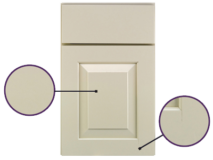
Painted Finishes
Availability varies on Maple and Oak - Several coats of heavily pigmented semi-opaque stain saturate the wood for rich, beautiful color while allowing some of the natural beauty of the grain to remain visible. The characteristics of the wood are less prevalent with painted finishes than with stained finishes. Since wood naturally expands and contracts, the joints on a door do the same. You may see hairline cracks in the finish surface at the joints. These joint lines are normal and do not affect the strength of the door's construction. Most painted finishes are available only on maple due to the uniform appearance and smooth, clean characteristics of the wood.

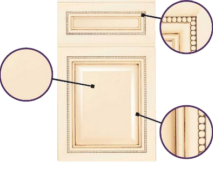
Paint with Glaze Finishes
Available on Maple, Oak, Cherry, Birch and Hickory - A base paint is applied to the wood for consistent color coverage. A flood coat of glaze is then applied and hand-wiped, leaving behind soft tones in the corners and recesses of the door. Next, a highlight glaze is brushed into the corners and recesses by hand to emphasize the subtle variations in color. Glazing is a finish process that involves two hand-detailed techniques, so no two doors look exactly alike. The initial flood coat of glaze softens the original base color. The highlight glaze increases visual depth and interest in the corners and recesses. A veneer center panel absorbs more of the glaze resulting in a slightly darker color than on the solid wood components of the door frame.

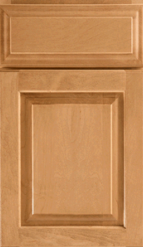
Stained Finishes
For a natural look, a stain color is applied and then hand-rubbed into the wood ensuring rich, consistent color coverage. Stains enhance the inherent beauty of each wood type. Natural characteristics such as wood grain, mineral streaks and knots become more prominent, which may create lighter or darker effects in the color. The color of a stain can vary on the various parts of the same door. End grain and veneer absorb more stain than other wood components of the door, resulting in a darker color. Chocolate and Muslin stains include flyspeck highlights. This technique involves a random spattering of a complementary finish color, which adds depth and dimension to the finish.

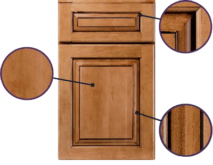
Stained with Glaze Finishes
Available on Maple, Oak, Cherry, Birch and Hickory - A base stain is applied to the wood for consistent color coverage. A flood coat of glaze is then applied and hand-wiped, leaving behind soft tones in the corners and recesses of the door. Next, a highlight glaze is brushed into the corners and recesses by hand to emphasize the subtle variations in color. Glazing is a finish process that involves two hand-detailed techniques, so no two doors look exactly alike. The initial flood coat of glaze softens the original base color. The highlight glaze increases visual depth and interest in the corners and recesses. A veneer center panel absorbs more of the glaze resulting in a slightly darker color than on the solid wood components of the door frame.

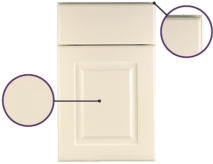
Thermofoil Finishes
This labor-intensive finish process gently turns back the hands of time, leaving a vision of heirloom cabinetry that has been well loved and equally used. First, the unfinished door and drawer fronts are uniquely distressed and over-sanded throughout. Next, several coats of heavily pigmented stain saturate the wood for a rich, beautiful color. This semi-opaque stain allows the perfect hint of wood grain to come through. The corners and edges of the door and drawer fronts are over-sanded once again, revealing the natural beauty of the cherry. The vintage finish technique involves multiple steps, which include random distressing and over-sanding, to create an aged appearance. Because of the hand-application of the different techniques, no two doors will look exactly alike. Vintage finishes are in the same family as painted finishes and share the same characteristics. As wood naturally expands and contracts, the joints on the door do the same. Hairline cracks, such as joint lines, may result. Joint lines are normal and do not affect the strength of the door's construction.

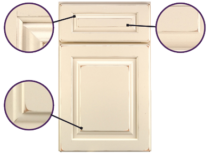
Vintage Finishes
Available on Maple, Oak, Cherry, Birch and Hickory - A base paint is applied to the wood for consistent color coverage. A flood coat of glaze is then applied and hand-wiped, leaving behind soft tones in the corners and recesses of the door. Next, a highlight glaze is brushed into the corners and recesses by hand to emphasize the subtle variations in color. Glazing is a finish process that involves two hand-detailed techniques, so no two doors look exactly alike. The initial flood coat of glaze softens the original base color. The highlight glaze increases visual depth and interest in the corners and recesses. A veneer center panel absorbs more of the glaze resulting in a slightly darker color than on the solid wood components of the door frame.
Cabinet Door Styles
Cabinet doors should be as stylish as they are functional. Luckily, there are virtually endless options of door styles. In any space, the cabinetry is the feature that will set the mood and décor for the rest of the room. You can also visit our section on Wood Characteristics and Kitchen Planning.
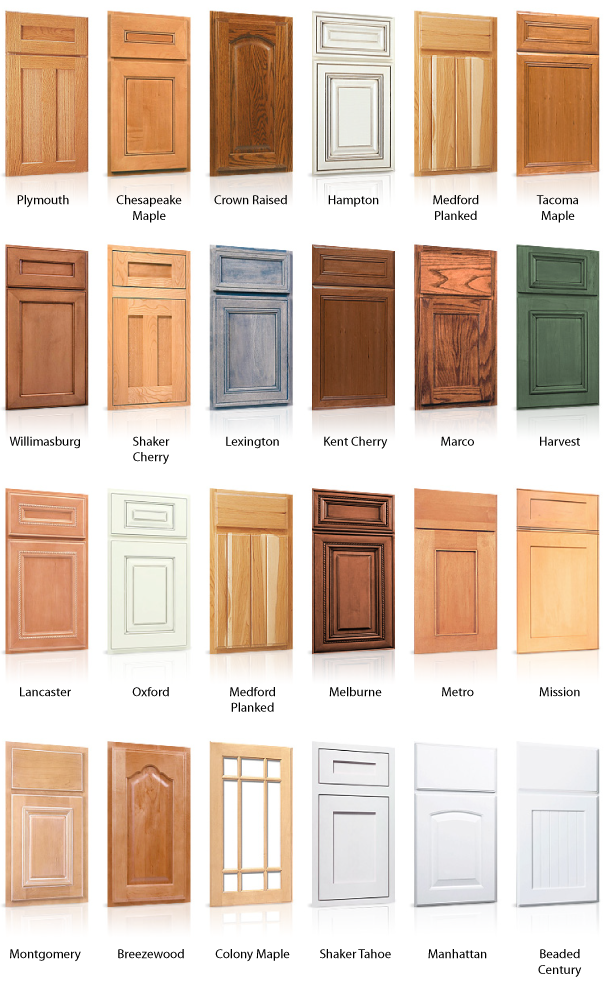
Every project we design has a layout best-suited to its need. Our architects will help you select the layout, materials and storage solutions that are right for you. We are ready to help, every step of the way.

